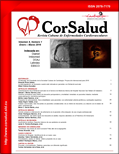Physical rehabilitation training program for peripheral artery disease in patients with ischemic heart disease
Abstract
Introduction: The ankle-brachial index provides a simple method to diagnose peripheral artery disease; its use allows identifying patients with intermittent claudi-cation of the lower limbs who do not successfully complete a cardiovascular stress test, which hinders their inclusion in rehabilitation programs.Objective: To design a comprehensive rehabilitation program for patients with peripheral artery disease and ischemic heart disease.
Method: An observational, descriptive, prospective and longitudinal study was carried out with 28 patients after an acute coronary syndrome and peripheral artery disease. A training program was designed and after a three months follow up results were compared with those at the beginning of the investigation.
Results: Male predominance (67.8%), 17 of them (60.7%) had an ankle-brachial index less than 0.9 (p=0.002). The most affected age group was 55-59 years (35.7%).The primary diagnosis was acute coronary syndrome with ST segment elevation (42.85%). The most common risk factor was hypertriglyceridemia (82.1%). Smoking (75%; p=0.005) and diabetes mellitus (28.6%; p=0.001) were significantly associated with a ITB≤0,9. After three months of supervised physical activity, the ankle-brachial index improved and increased time on exercise (4:21 vs. 10:9 minutes) and onset of pain (2:31 vs. 7:6 minutes).
Conclusions: The introduction of supervised training programs for peripheral artery disease improves functional capacity of patients and their comprehensive evaluation, which favors joining cardiovascular rehabilitation programs.
Downloads
Download data is not yet available.
Downloads
Published
2016-01-21
How to Cite
1.
Negrín Valdés T, Lage López LM, Hernández Toledo C, Castellanos Gallo L, Fardales Rodríguez R, Santos Pérez A, et al. Physical rehabilitation training program for peripheral artery disease in patients with ischemic heart disease. CorSalud [Internet]. 2016 Jan. 21 [cited 2025 Dec. 1];8(1):29-37. Available from: https://revcorsalud.sld.cu/index.php/cors/article/view/94
Issue
Section
ORIGINAL ARTICLES
License
Authors who publish with this journal agree to the following terms:- Authors retain copyright and grant the journal right of first publication with the work simultaneously licensed under a Creative Commons Attribution License that allows others to share the work with an acknowledgement of the work's authorship and initial publication in this journal.
- Authors are able to enter into separate, additional contractual arrangements for the non-exclusive distribution of the journal's published version of the work (e.g., post it to an institutional repository or publish it in a book), with an acknowledgement of its initial publication in this journal.










